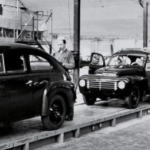
Being in the “continuous improvement” business, like any role, has its challenges. My directive to reduce chaos tends to interrupt employees’ day jobs and has the tendency to create some interesting upheaval. The most pronounced being that co-workers just do not have the time to engage in improving what they do because they are too busy or their “Whirlwind” is too big.
The sarcastic side of me always wants to ask if the real reason is “that they just don’t care”. The emotionally intelligent side of me says “It doesn’t matter if they don’t care”, “take the high road”, “try to demonstrate why investing the time is important”. I wish everyone could simply see change how I see it:
A way to remove the chaos, working within a framework to work smarter not harder (cliche – I know).
Before I go too far, let me say that I do believe that most people strive to do a good job and work hard with what they are given. But for the sake of this article, most people “miss the forest for the trees” as to why it’s important to spend time improving tasks and flow.
I love it when my wife or one of my children calls me at work and asks me if I am busy. That question has always made me laugh a little. I love responding with “nope, just sitting here waiting on your phone call”. Again, sarcastic, I know. But, this made me think. We do, naturally, fill our time. Especially when it comes to work. Part of what we believe brings our value to the company is our ability to stay busy no matter the task. And if we are not constantly filling the voids with an obscure activity, then we believe our job might be in jeopardy, we will be fired, released, demoted, etc. If that’s the case, you might be in the wrong position or company.
I truly believe we all develop our own “Whirlwind” and that some of the time we are neither focused on what’s important or our “Whirlwind”.
The voids mentioned above need to be looked at as opportunities. Time in which you can improve the status quo, tackle a project, support a team. We always talk about tackling the “low hanging fruit” – tackle those. In other-words, do something to reduce or remove the “Whirlwind”.
If you believe that everything you do each and every day brings value to the company, matches your directives and includes activities to continually improve your ability to make change – then amen, you are on your game and you can stop reading. But…. if you are trudging through your daily activities with no change in site and lots of ideas. Then by all means come to the front of the class and let’s discuss getting out of the “Whirlwind”.

Getting out of the “Whirlwind”
Getting out of the “Whirlwind” is a mindset and a choice. You have got to decide that the effort is worth the investment and that there will be benefits incurred by traipsing down the path. I have met people that will always tell you they are busy and do not have time for change no matter what. In my personal opinion these people do more long term damage than good. Everyone should engage in making things better. This statement by W. Edwards Deming rings oh-so true.
A bad system will beat a good person every time
I believe that most everyone wants to do their best given the context and environment at hand. I subscribe to Deming’s views that it is the organization as a system, not the people working in the system that determines the organization’s performance. But it is the people that have to engage.
So, when it comes to dealing with the “whirlwind” and looking to improving performance, there are generally three options that are considered:
- Add more people (or resources) – This option usually does not actually improve performance and has budgetary and financial implications. Also, the individual can only suggest this to leadership as an option.
- Work harder – This is usually done with overtime to solve the problem at hand and while this may resolve the immediate need, it does not solve the problem in the long run. This option usually spirals, gets worse and sometimes becomes the norm (which is not good).
- Improve performance – This one is usually done through investment in training, applying lean-thinking, removing waste, improving flow, and experimenting with new ideas, to name a few. Time spent out of the “whirlwind” and improving process capability typically yields the more enduring results and change.
Out of the three considerations listed above, I hope that you can see that #3 is the preferred road-map and will give lasting benefits. #3 should be ingrained into the culture. There is no way I would encourage an organization to implement options #1 or #2 into their culture.
Of course, there are a lot of efforts and initiatives that an organization can take to remove the “Whirlwind” and focus on improving performance. But I am writing this article to individuals, so I would like to list some simple guidelines that individuals can take to step outside their “Whirlwind” and make a difference.
- First, you have to want to – enough said.
- Adopt a continuous improvement mindset (or Kaizen). This is done with a habit of regular retrospectives and operational reviews. Spend some time identifying improvement opportunities. The culture of Kaizen is one of the reasons why Toyota has been so successful. Kaizen is about making small improvements continuously.
- Manage your work calendar, relentlessly. At the end of each week look at next week and block out the important activities – the must do’s. Then mark the calendar daily with time and actions that will help to improve things. Make a list and spread them out on your calendar. Then HOLD to your calendar. Try not to change anything.
- Work with your manager and leadership to understand what’s important and how it relates to you. Schedule regular “upward” meetings. This will allow you to remove those items that are not important or are not bringing value. Your manager or leadership does not always know what you are dealing with. Help them to understand – in a positive way.
- Some suggestions or changes are bigger than what you can make alone using Kaizen as stated above but go ahead and make a list of things needing to change or be improved. This might be a very long list and there are rules to this one. You do not want to come off as a complainer. So rule #1 With every issue bring to the table three possible solutions. Rule #2 Always include yourself as part of the solution.
- Some other helpful habits are: 1) keep meetings short and effective, have an agenda, stick to the allotted time and hold people accountable to being on-time and prepared. 2) make sure you question the importance and value of a task. 3) Also, there are no bad ideas.
When the focus is constantly on production, delivery or working overtime then these activities quickly become routine; now you’re in the “Whirlwind”. Capability starts to decay and as a result, performance gaps increase forcing the need for heroic efforts (that sometimes get rewarded) and people work harder and longer hours which take them further away from improvement.
The “Whirlwind” is very real. When organizations allow this slow decay to happen it’s usually because they have a foreshortened view of what’s important, the “Culture of Kaizen” is missing and usually leadership does not have a balanced mentality to key organizational strategies.
There is no doubt that you were hired to “Get Things Done”. Just remember to work on the right “Things” and work to make something better each and every day.




